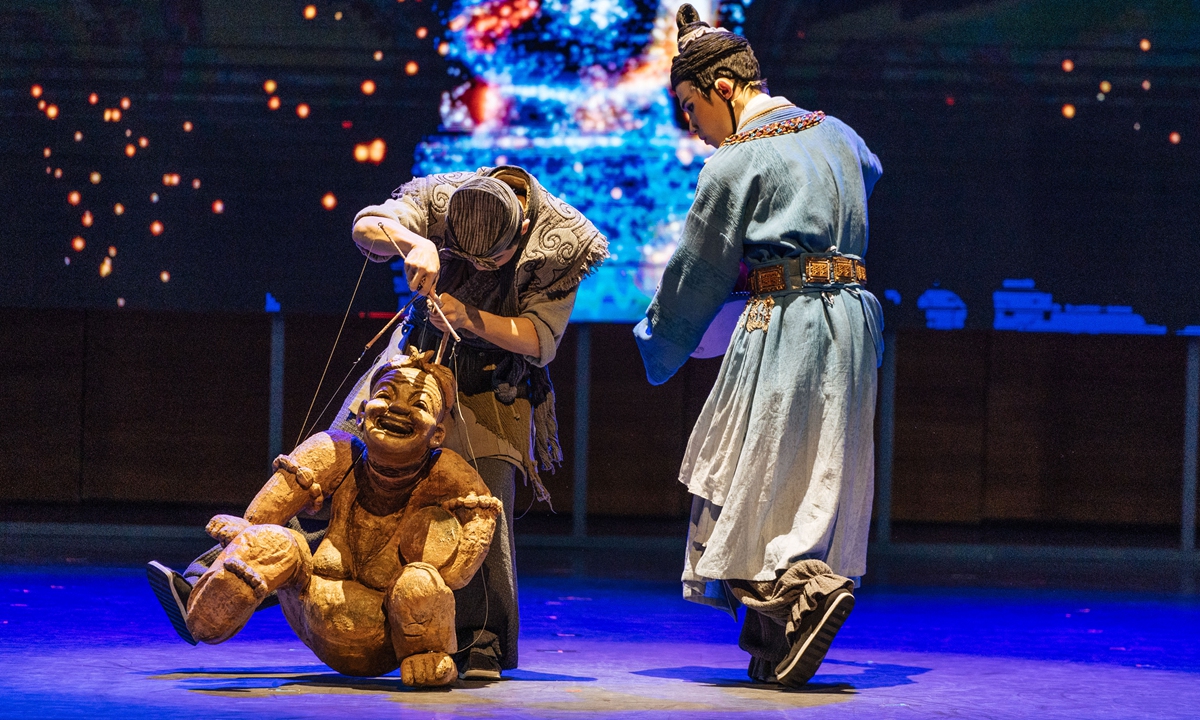
Artists perform at the National Museum of China Theater in Beijing on May 27. Photo: VCG
Inspired by one of its star cultural relics, the "Pottery Storyteller Beating a Drum," the National Museum of China's (NMC) first original dance drama Joyful Songs in a Flourishing Age has been performed at the NMC Theater.
A drum-beating pottery storyteller represents the earliest form of narrating and singing in Chinese culture, a form which provides the original pattern of Chinese folk art and Chinese opera.
Using a modernized version of traditional performing arts, a 2,000-year-old drum-beating pottery storyteller from the Eastern Han Dynasty (25-220) was brought back to life on stage, conveying the optimistic spirit and persevering character of the Chinese nation.
Perfect integration
Jointly produced by the NMC and the Communication University of China (CUC), Joyful Songs in a Flourishing Age is the first attempt to revive Chinese cultural relics on stage as well as a project of the CUC to serve the major cultural strategy of creative transformation and innovative development of traditional Chinese culture. The drama is.
"Close to reality, life and the masses." The play is people-oriented, channeling its artistic creation through paiyou (comedians) who lived by the banks of the Jinjiang River on the Chengdu Plain 2,000 years ago.
Taking the Han Dynasty pottery storyteller beating a drum as its main character in the performance, this play retells the ups and downs of the lives of paiyou living in the lower strata of Han society through three sets of stories and four scenes represented with the traditional performing arts of vaudeville, narrating and singing opera and modern drama, opera, music, dance, rap and other diversified forms of expression.
"The characteristics of this dance drama are integration and humor. It includes a blend of ancient and young, traditional and modern, cultural and educational, as well as a blend of various artistic techniques," the head of the office of the Leading Group for the Revitalization of Cultural Relics in the NMC, who declined to be identified, told the Global Times.
"At the same time, it captures fun and humor, regardless of the ups and downs of personal experience, it always promotes an optimistic attitude towards life, and it brings joy to the audience," he added.
The costumes of the characters and the stories inspired by classical ancient history are restored to immerse the audience in the distant Chinese stories through the performance.
"The whole stage performance is excellent, especially noteworthy is the use of various fashionable musical elements. It makes the drum-beating pottery storyteller from 2,000 years ago echo the music of today across time and space," said one of the spectators.

Artists perform in the dance drama Joyful Songs in a Flourishing Age in Beijing on May 27, 2023. Photo: Li Hao/Global Times
Breaking the circle
In recent years, many museums in China have used collected data for exhibitions and used high-tech equipment to accurately display the information contained in cultural relics, so that the audience can see them more clearly, and allow cultural relics to break out from traditional boundaries by using new media such as live TV, stage performances, immersive experiences, virtual exhibition halls and online short videos.
The Tianjin Museum, together with JinYun New Media, developed "VR Tianjin Museum" in 2022, an immersive exploration of museums empowered by digital technology. In addition, the museum launched a creative augmented reality short video to show the beauty of the masterpiece by Qiu Ying, a well-known painter of the Ming Dynasty (1368-1644), which enables the audience to immerse in the wonderland-like atmosphere created by the painting.
Another museum in Luoyang, Central China's Henan Province, launched ancient tomb-themed script-kill games, allowing visitors to fall into the "gap between history and reality," and only by exploring the various tombs in the museum and activating different cultural relics and find clues to return to reality.
Museums have creatively enriched cultural relics with new technologies and means, allowing people to see the achievements of Chinese civilization that have accelerated the "breaking of the circle."
"To make cultural relics come alive, it is necessary to let the cultural relics in the museum go out of the museum and to the exhibition line, and to vigorously promote the digitization of cultural relics, use advanced technologies such as big data, cloud computing and artificial intelligence to accelerate the popularization of cultural relics, constantly optimizing communication, enriching communication channels, strengthening the interaction between the audience and the cultural relics and inject ancient cultural relics with new vitality in the contemporary era," said the NMC official.
URL: https://www.seeglobalnews.com/read-1750.html